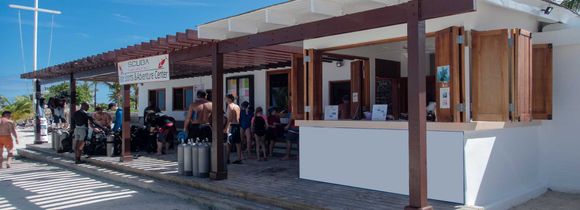Runaway Bay Diving
Runaway Bay located on the northern coast of Jamaica hold an interesting mix of dive sites to excite a wide range of divers. With a warm climate and clear waters, the diving conditions here are ideal for the divers exploring the wrecks, steep reef walls, canyons while admiring the many marine species.
Diving in Runaway Bay
Runaway Bay is a small but popular beach town located in St Anne's Parish on the northern coast of the island of Jamaica, which lies in the Caribbean Sea. The town attracts many visitors due to its fantastic beaches and great diving opportunities. There are a mix of independent dive centres as well as dive resorts located inside the all inclusive resorts here. There are 17 official dive sites and range from shallow reefs, to steep wall dives to deeper wreck dives, all surrounded by clear waters. With a warm climate throughout the year, a high abundance of marine life and the many other perks that a Caribbean island brings, this is a beautiful destination above, and below the water.
Best time to dive
It is possible to dive here all year round, but between June and September the conditions are at their best. October to May there is more chance of rain but it will very rarely impact diving. Due to the air temperatures being warm throughout the year, the water temperatures are between 26 and 28 degrees Celsius throughout the year. The visibility is great overall with an average of 25 metres with reaching over 35 metres in the peak diving season.
Types of diving
With 17 dive sites there is quite a variety of types of dives to be done here. There are wrecks including a tug boat wreck and two airplane wrecks. There are shallow reef dives where divers can spot a multitude of marine life which are also ideal sites for night dives and for underwater photographers. There are different types of rock topography such as steep coral walls, coral plateaus, canyons, and caves. There are also some opportunities for drift dives.
What to see
Runaway dive sites have a plethora of marine species. The reefs here are thriving and covered in different species of Hard Corals and Soft Corals and Sea Fans, but the star of the show is definitely the Sea Sponge. Some of the many sponge species include Yellow Tube Sponges, Green Rope Sponges, Vase Sponges and Elephant Ear Sponges. This area is also has many schools of colourful reef fish which fill the waters including Blue Chromis, Wrasse, Rainbow Jacks and Barracuda. Some of the other species which have been spotted here include Eels, Stingrays, Sea Turtles and on the best days Dolphins have passed by here.
Best places to dive
Planes is a dive site made up of two plane wrecks which lie next to a steep drop off at 23 metres and the story is that these planes allegedly were used to transport marijuana. Divers are able to explore the cockpits and spot Sea Turtles here.
Nursery is the top shallow reef dive which is often used for dive courses, night dives and for underwater photographers to capture the many marine species which inhabit this site.
There are many other dive sites here not to be missed including 100 foot tugboat wreck named the Reggae Queen, a deep Canyon and steep reef walls at Pocket Reef and Groupers Drop.
